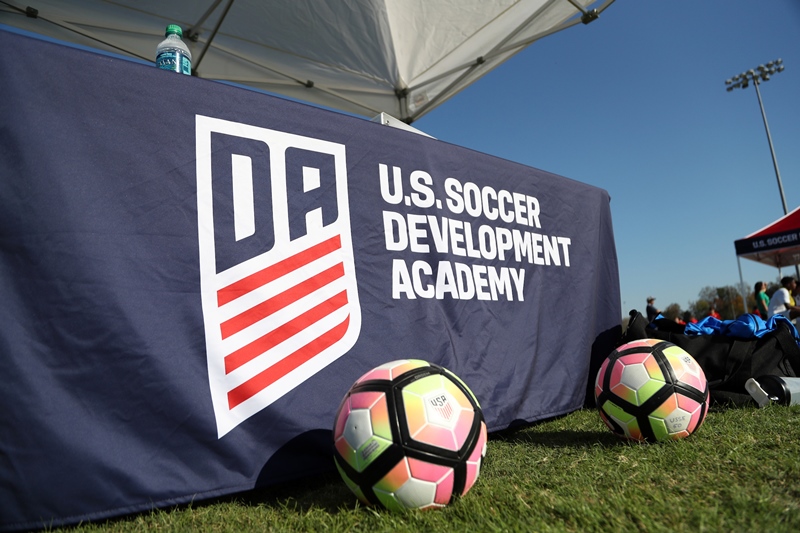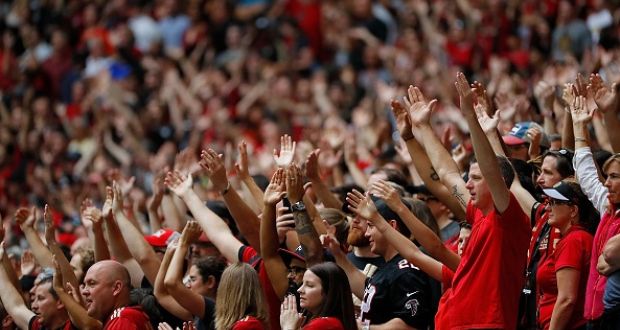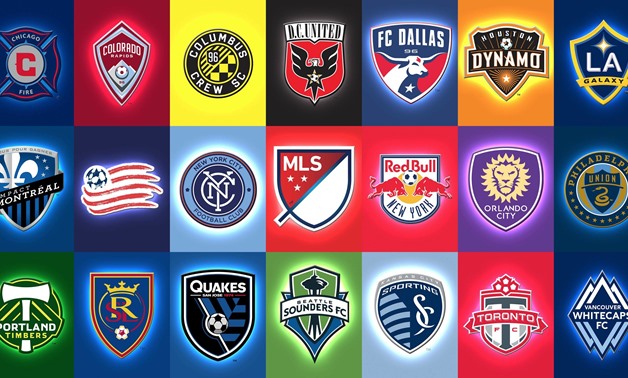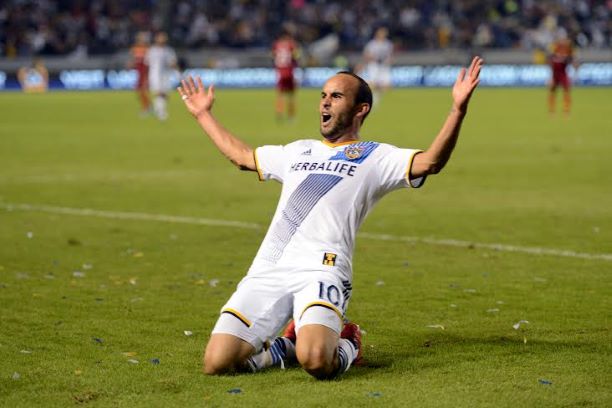The Ongoing Learning Process
The Ongoing Learning Process

“For me, life is just an ongoing learning process.” - Jurgen Klinsmann

By John Smith-Ramos, writing from Washington DC
It hasn’t been the ideal start for Juergen Klinsmann. A draw against Mexico, followed by a pair of 1-0 losses - home and away - over the past week is not particularly impressive form. 3 games, however, and friendlies at that, are not enough to start judging Klinsmann based purely on his results. But is it also too soon to ask if the team is headed in right direction? And what direction is that, exactly?
Klinsmann’s long-term goal, at least, is simple. The US needs to advance out of its group at the 2014 World Cup in Brazil. Simply qualifying for the tournament is no longer enough. The past two decades of growth, on the field and off it, has turned the US from plucky underdogs to regional power. The CONCACAF region is simply not strong enough to justify a soccer program of the US’s size and wealth’s failure to reach international football’s biggest stage.
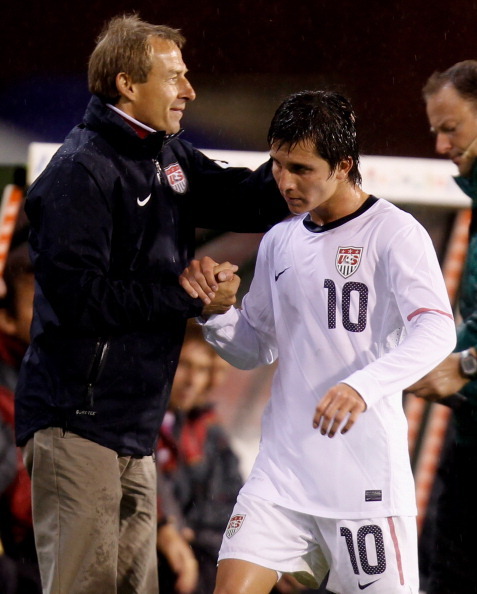
However, just because American fans have come to take World Cup qualification for granted doesn’t mean it’s going to be easy. Fueled by the rise of Chicharito, the gulf in class between the USMNT and Mexico appears to be widening, and, as Friday’s defeat against Costa Rica reminds us, there are signs that the smaller countries may just be beginning to fancy their chances of overtaking the United States. Reversing that trend will be Klinsmann’s immediate short term goal as US boss. Why is that happening? Because time is catching up. The team’s two most talented players (proven talent at least), Landon Donovan and Clint Dempsey, will be 32 and 31 by the time 2014 rolls around. Both will have a lot of miles on them – it will be Donovan’s 4th Cup, Dempsey’s 3rd. At the back, team captain Carlos Bocanegra will be 35. Assuming he’s still playing, it will be his 3rd World Cup as well. It’s no guarantee that US fans can expect the kinds of performances from them in 2014 that they’ve seen in the past. Replacements must be found. To his credit, Klinsmann seems to realize this, and the three friendlies the team has played so far have been marked with plenty of fresh faces. How Klinsmann tracks these players’ development over the next 2 years and fits them into his squad will be the key to his success or failure as the team’s manager. It’s a new era.
Ideally, I’d like to see a team that goes forward, that takes riskes and expresses itself, and say we also want to have a good time.
“We want the people to identify with their team.. If they go to the stadium, I want the people to be happy with what they [see], the energy level they have, the fighting spirit, and also a certain risk-taking approach.”
Sounds great. I’m guessing most soccer fans would want their team to play attractive, attacking soccer. Klinsmann has announced repeatedly - first with the German national team, then with Bayern Munich, now with the US, that his philosophy as a manager is to look for players with excellent technique, and the skill and craft to play the ball out of dangerous positions. In practice, this means an emphasis on ball possession and slick passing, with plenty of attacking players on the pitch to go for goal.
Goals, goals, and more goals! It’s long been the dream of many in the US Soccer community, and not just because of romantic notions about the purity of the beautiful game. A smooth, entertaining, high-scoring team hast the potential to seduce fans and help grow the sport in the United States – ideally driving up MLS attendance and tv viewership in the process. The MLS has long been tied to the US Men’s national team – it was founded in 1993 as part of the US’s bid to host the 1994 World Cup, and attendance and ratings spike (relatively) in World Cup years.
This connection is literally embodied by the man who hired Klinsmann, US Soccer Federation president Sunil Gulati. Gulati first courted Klinsmann in 2006 after the German, with a little help from home field advantage, led an unheralded but entertaining German side to a 3rd place finish in the 2006 World Cup. Their relationship resumed after the 2010 World Cup and now, at last, Gulati has his man. There’s nothing wrong with wanting to play open, attractive soccer and attract fans, and there’s no reason it shouldn’t be Klinsmann’s stated goal. The challenge is getting the right players.
“ We want to dig into the Latin community and we want to get those kids … And we don’t want them to go back to their home countries. We want them to become real American players.”
It’s a problem facing international sides all over the world – particularly in Europe. As immigrants come to new countries and have children, some of those kids end up becoming world class footballers. They’re then faced with a choice - play for the national team of your adopted country, or that of your homeland. It leads to strange situations - the Boateng brothers in Germany, for example, in which Kevin-Prince opted to play for Ghana, while his brother Jerome plays for Germany. It can also be controversial - in many cases these players come up through their adopted nation’s football associations, which use their wealth to fund academies, camps, youth teams etc… only for another country to reap the rewards. (Of course, the wealthy country has reaped its own rewards already.) France national team manager Laurent Blanc was recently came under fire after tapes surfaced on which he appeared to suggest quotas for the number of non-white children that would be allowed to train for the French national team. As Observer columnist Andrew Hussey points out, what was lost in the scandal was that Blanc was - awkwardly - trying to address the “problem” of French-trained players leaving to play for other countries. That, less awkwardly, is what Klinsmann was getting at.
Data in from the 2010 Census estimates that there are over 50 million Latinos in the United States today – and 1 in 4 children. Many of them will be playing soccer, and an even higher percentage are potential fans. It’s no coincidence that ESPN has incorporated ESPNDeportes personality - and former Univision news anchor - Jorge Ramos into its broadcasts of all three matches of the Klinsmann era. The network has deep ties with US Soccer. Of course, the goal will be to hang on to top talent of any ethnicity; US soccer can ill afford to let another player like Giuseppi Rossi, now of Italy and Villareal, go. Statistically, targeting Latino players is a tactic that makes long-term sense for US Soccer, which should be scouring the country to keep talent of any race, creed, or color. But if Klinsmann’s going to stick around to see that tactic pay off, he’s going to need to produce results on the pitch. To do that, he’ll need to find the right combination of player selection, training, and tactics to fit his philosophy. Let’s look at how he’s doing so far.
THE FRIENDLIES
August 10th: USA 1 - 1 Mexico
Klinsmann’s first game in charge. Arch-rivals Mexico had just put the final nail in his predecessor Bob Bradley’s coffin by hammering the US 4-2 in the Gold Cup final. A bad result here wouldn’t have been fatal by any stretch, but it wouldn’t have been good PR either. Some experience was required. He also wanted to show off his new philosophy, and begin to bring in the new blood. So a team selection mixing veterans and fresh faces is in order.
There’s a problem, though - and not exactly the one he wants to solve. The demise of Oguchi Onyewu has left a gaping hole in the US defense, which was already creaking mightily under Bradley, conceding 13 goals in 10 matches in 2011. The left back position, so often the weakest on the pitch for any team, has been an ongoing nightmare. So Klinsmann wanted a team and a formation that can fulfill his dreams of attacking football without putting too much pressure on the defense. He opted for the 4-2-3-1.
Team Selection: Torres, Beckerman, Castillo and Fiscal
Into the defense came two new faces – left back Edgar Castillo and center Michael Orozco Fiscal, both making just their second appearance for the US. They joined experienced US internationals Steve Cherundolo (at right back) and captain Carlos Bocanegra (CB) to make up a back four. Fiscal is not particularly large - he’s 5'11’ - so not a like for like replacement for the hulking Onyewu. Castillo is downright slender, and seemed visibly nervous to start the game. Understandable perhaps, given that he was facing his former teammates: Castillo, interestingly, previously played for the the Mexican national team, appearing as a substitute in 2 friendlies. A recent rule change means that only appearances in competitive international matches tie you to a country - friendlies don’t count. Shielding this new back 4 were two defensive midfielders, Kyle Beckerman and Jermaine Jones. Jones had made fairly regular appearances under Bradley in the past year, but this was Beckerman’s first cap since 2009.
Ahead of them, in a band of three spread across the pitch, were, from left to right, Jose Torres, Michael Bradley, and Landon Donovan. Donovan and Bradley, of course, are well known. When last we saw Jose Torres, though, he was making a disastrous appearance at the World Cup in South Africa. Torres started the US’s game against Slovenia, and was substituted at halftime with the team down 2-0. It was the first exposure most Americans had to the young playmaker, though devoted fans had heard much about the 23 year old’s good passing and technical skill. Incidentally, Torres, like Castillo, was eligible for both the Mexican and US national teams, and though he never appeared for El Tri, does play his club football in Mexico for Pachuca. Playing as a center forward for Klinsman was MLS man Edson Buddle, making his 6th appearance for team USA.
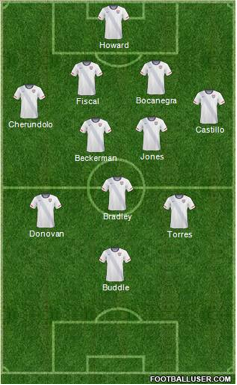
Tactics
Klinsmann had clearly told his team, including goalie Tim Howard, to try to play from the back, to pass the ball to each other’s feet all over the pitch in an effort to build momentum going forward, rather than kicking it long toward Buddle. Stringing passes together is a key part of the style Klinsmann wants to play. Unfortunately, the team really struggled with it. Beckerman is not a strong passer - he’s there largely to defend and make tackles, breaking up opposition moves. His first instinct when getting the ball is to go backwards, the easiest route away from pressure. Jones, alongside him, was meant to link defense and attack, but he had a very poor game, and struggled to get on the ball. Mexico didn’t press too aggressively, but they were well organized, and managed to funnel the ball out wide to the fullbacks Castillo and Cherundolo, who had few options. Castillo in particular struggled. Klinsmann clearly wanted him to get foward, especially as Torres was to tuck into the middle, but he struggled on the ball, and his slender frame meant he had trouble holding off stronger opponents.
Torres, for his part, lacked positional discipline and drifted very deep to try to collect the ball, though this was partly due to Jones’ and Castillo’s struggles. Donovan came back a fair amount as well. As they did, it allowed Mexico’s press to move up and compress the space in which the US could play. As a result, Bradley was in no man’s land, far from everyone, and also saw very little of the ball in the first half. When Buddle did manage to knock down a few long balls - which the US inevitably resorted to - there was no teammate near him to collect.
The good news was the the US looked more solid defensively, with Jones and Beckerman in particular working hard to break up the Mexican attacks. It is worth noting, though, that Chicharito was unavailable for this game, and the replacement Mexican forward Peralta was a pale imitation.
The exception to that defensive strength was Castillo, who looked vulnerable, particularly to balls hit long over the top, which he let bounce into dangerous areas more than once, usually as he struggled to hold off an attacker. Fiscal had little to do. Mexico did score, of course, from a set-piece, when Peralta caught Bradley napping to stab a volley home.
The pattern of the game only changed with the subsitutions in the second half. Mexico, in typical friendly fashion, made a wave of substitutions early in the second half and seemed to lose focus. Klinsmann, tellingly, treated the match more like a competitive game. He only made 3 changes, and used them to make a tactical shift. He went first to a 4-4-2, taking off Jones and Buddle, and bringing on forwards Brek Shea and Juan Agudelo. 10 minutes later, he made it a 4-3-3, bringing on Robbie Rogers for Bradley. The switch worked: Agudelo, Shea and Rogers combined for a tap-in goal. Klinsmann had pushed the right buttons.
It was a mixed performance - Mexico were better than the US for much of the game, and Chicharito could have made a significant difference. But Klinsmann made a nice adjustment, and used his subs to change and strengthen his team - that’s good in-game management.
September 2nd: USA 0 - 1 Costa Rica
Played at the Home Depot Center in Carson, California. Kickoff time was at 8pm Pacific. Costa Rica came in in a bit of disarray - they had just hired a new manager, but he hadn’t started yet, so they were led by interim manager Ronald Gonzalez. Los Ticos were also without a handful of regular starters, including first choice strikers Joel Campbell (Lorient on loan from Arsenal) and Bryan Ruiz (Fulham). This was probably a game Klinsmann had been looking forward to - a chance, against a supposedly weaker opponent, to showcase the stylish soccer he’s been cultivating for the last month. With Costa Rica offering (presumably) less threat going forward, he decided he could afford to do without an extra defensive midfielder, and so this time his midfield featured just one holding player - Maurice Edu.
Team Selection: Shea, Rogers, and Timothy Chandler.
Klinsmann, again perhaps because he was unafraid of Costa Rica’s attack, introduced Timothy Chandler into the right back position for Steve Cherundolo. Chandler is another player who had to make an international choice – he was born and raised in Germany, where he still lives and plays. Chandler, physically, looks more like what you’d expect from an international full-back – he’s significantly bigger than Castillo. The rest of the back line was the same as against Mexico: Orozco, Bocanegra and Castillo – meaning that there were three players around Bocanegra who were all making their third international appearance for the US. Sitting just ahead of them was Bob Bradley’s old friend Edu, an experienced pro and international – important given the fact that the four men behind him had never played together.
Just ahead of Edu was Jose Torres. On paper, before the game, it looked like Torres role here was to sit as a deep lying playmaker, collecting the ball when the US won it and then orchestrating the attack - a more attacking version of the role Jermaine Jones played against Mexico . Ahead of Torres were, left to right, Brek Shea, Landon Donovan and Robby Rogers. Shea, who had particularly impressed against Mexico, was making his first career start for the US. Robbie Rogers had played before under Bradley, but had fallen out of favor and had been cut from the World Cup roster in 2010. Ahead of them was first choice US striker Jozy Altidore.
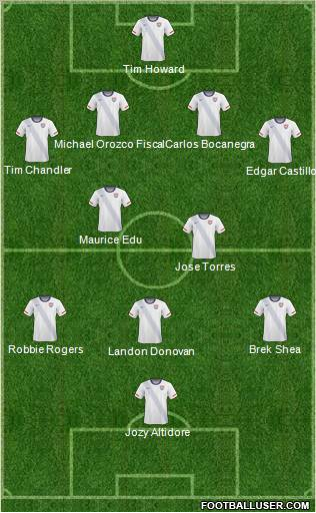
Tactics
As the game began though, it gradually became clear that the US shape was slightly different than it appeared. Edu, the defensive midfielder, was to sit very deep and provide cover for the back four. Of that four, Chandler and, especially, Castillo were encouraged to get forward when possible. Shea and Rogers were meant to give the US attack width, getting down the flanks and then cutting in towards the middle - thus giving the fullbacks space to overlap.
Torres may have been meant to sit deep beside Edu, but, either by design or by temperament, he often pushed further up the pitch, closer to Donovan. For his part, Donovan also had the freedom to get forward into the box up the middle or come back to try to be a playmaker, alongside Torres. The result was a system that looked at times like a 4-1-4-1 and at times like a 4-3-3.
The 4-1-4-1 and The 4-3-3
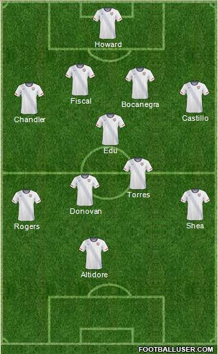

For the opening half hour, it seemed to be working. The US completely controlled possession, with Torres particularly influential. He saw a lot of the ball and was able to play some nice passes as the US moved into the Costa Rican final third. Castillo got forward aggressively, as did Chandler. The US moved quickly, and Costa Rica was forced into fouling repeatedly to stop them. Setting up a couple of free kicks in good positions.
Still, for all their movement and aggressive play in the opening 35 minutes, there was also a marked aimlessness from the US in the final third. That, combined with some very poor crossing (especially from Castillo and Chandler), meant that they created very few scoring chances. The best one came in the 6th minute, and will have made Klinsmann happy. Shea and Altidore combined well, as Shea cut into the middle, before delivering a lovely ball across the box to Donovan, who put his shot wide at the far post. After that miss, a goal seemed sure to come soon. In fact, it was their last real chance of the match.
Costa Rica were surprisingly cunning. On paper, they were a 4-3-3, but in practice Martinez played further back, making it more of a 4-5-1 - meaning they seemed prepared to sit back and weather the early storm of the US. After the first five minutes, they were happy to sit back and soak up the US pressure even as the Americans ran furiously around them. They were waiting for the US to run themselves out.
Sure enough, 35 minutes in, they began to find a foothold, and even, on the stroke of halftime, managed to manufacture a couple of chances of their own. It was a warning sign of things to come. At half time, Gonzalez moved to a more attacking 4-3-3, bringing forward Daniel Colindres on for Martinez, and telling to play further up on the right and attack the US’s defensive weak point: Castillo. The game changed completely. Costa Rica began dominating, with Colindres repeatedly exposing Castillo, whose play (under pressure) in and out of possession became increasingly erratic. In the 58th minute, he outmuscled him to deliver a good cross into the box which nearly led to a goal.
When the goal did come, it was a failure of both tactics and training. It’s worth watching a few times to fully understand what happened. MF Alvaro Sanchez picked up the ball just inside the US half. He was in a ton of space - because Jose Torres is hopelessly out of defensive position. On the replay you can see the alarm bell go off in his head at 3:04 as he recognizes the danger - too late. Torres needed to be more disciplined and aware, for sure, but that’s also a function of tactics: Klinsmann started only one defensive midfielder, Edu, who at 3:05 is seen sitting deep in front of his back four, and faced with two men running at him. It’s also worth noting that Torres may have been sucked toward Colindres to help the beleaguered Castillo.
Things quickly go from bad to worse. The US have numbers back but, perhaps frozen by Torres’ error, Edu hesitates eaving the man on the ball with time and space, while Bocanegra and Fiscal miscommunicate, blowing the offside trap and allowing the striker Saborio to get behind them – into the space behind Castillo–without being tracked or caught offside. As they race to recover, Castillo compounds the error by jogging back, making no effort to cover the space in the middle emptied by his center backs. In all likelihood, he would have been to late anyway, but that’s because he, like everyone else, was far too late to see the danger. Finally, Edu fails to track Sanchez as he continued his run into the box, leaving Chandler with 2 men to cover. Fatigue? Sanchez gets in front of Chandler, producing a fine save from Howard, but the rebound falls right to Wallace for the diving header. Goal. The US was ripped apart.
The goal came just after Klinsmann had made a change, replacing Altidore with Juan Agudelo. He followed it up with another, two minutes later, bringing on Sacha Kljestan for the ineffective Robbie Rogers. But those were his only two subs – was he again treating it like a competitive match? Trying to push his players to be fitter? It’s unclear. The US tried to rally, but they were visibly fatigued, and never really looked like scoring.
Ronald Gonzalez may have been the interim manager for Costa Rica – but he got his tactics spot on in this case. He waited for the US storm to blow out, then exposed the team’s fatigue and defensive weak points with a substitution and a formation shift. Let’s hope it was a valuable lesson for Klinsmann.
September 6th Belgium 1 - 0 USA
4 days and 9 time zones later, the US turned up in Brussels to play a young, talented, but still underachieving Brussels team. Brussels had played a qualifying match on Friday in Azerbaijan, where they suffered an embarrassing draw that put them in serious danger of not qualifying for the 2012 European cup. They have the kind of budding stars Klinsmann would kill for - defender Vincent Kompany of Man City, midfielder Marouane Fellaini of Everton, fellow afro enthusiast and Benfica man Axel Witsel, and, especially, Eden Hazard of Lille, an attacking midfielder that all of Europe’s heavyweights are eyeing for next summer’s transfer market. In theory, this is a serious step up from Costa Rica – away to a European team - but Belgium’s recent form and history of indifferent performances (and a population with a notorious lack of nationalist fervor) suggested that they might just be there for the taking. A pouring rain meant that no one looked happy to be there.
Team Selection - Goodson in, Castillo and Fiscal benched.
The most notable change for the US was at the back. Klinsmann may just have benched Fiscal because of fatigue, or too get a look at Clarence Goodson, but Castillo’s move does not bode well for him. He actually wasn’t even on the bench - he was a game day scratch. That left the US without only one natural left back in the lineup - Carlos Bocanegra, who has become too valuable as an emergency center back to move out wide. To fill the hole at left back, he put in Timothy Chandler - making just his second US start, returning Steve Cherundolo to his natural right back position. This was Chandler’s first appearance at left back at any level. Goodson, who plays for the Danish club Brondby, slotted in alongside the ever-present Bocanegra to make up a back four.
In front of them, again, was a single holding player, Maurice Edu. He played behind two attacking midfielders, Jose Torres, and Clint Dempsey, who, as previously arranged, came in for this game, replacing Landon Donovan who went back to L.A. So, if your scoring at home, neither star US player had to make the gruelling trans-Atlantic trip from their club to a friendly. That will no doubt keep them and their respective clubs happy going forward. Ahead of Torres and Dempsey were the same front 3 - Brek Shea, Jozy Altidore and Robbie Rogers.

Tactics
In short, it was the same team shape as against Costa Rica – an attacking 4-3-3 that more often looks like a 4-1-4-1, with Shea and Rogers dropping back to form a 4 man midfield with Torres and Dempsey. Much as they did against Costa Rica, the US started brightly. In the 5th minute, Dempsey had a free kick in a dangerous position. He hit it well, skipping it just in front of the keeper who briefly flubbed it before recovering to do just enough to keep it away from the onrushing Altidore. Unfortunately, just as with Donovan’s near miss against Costa Rica, it was to prove the US’s only real chance of the game.
With the US trying to play out of the back again, Torres started well, looking to play nice passes and spread the ball around to his teammates. Dempsey, on the other hand, was virtually invisible after his free kick – the Belgian midfield was determined to mark him out of the game. There was also little help from Robbie Rogers who looked slow of step and thought, losing the ball and getting caught offside repeatedly. So most of the creative early play came from Brek Shea, who, as against Costa Rica, looked to run at his defender whenever possible. Belgium were also playing a 4-3-3, with Hazard on the left and Witsel on the right, and after a slow start, they began to get a grip on the game, with Hazard increasingly influential. In the 15th minute he caught Torres in possession, springing a dangerous counterattack. He began to attack Rogers and Cherundolo, getting behind both and, in the 18th minute, forcing a foul on the edge of the box - which the US defended well. In the 25th, he and Witsel combined to catch out Rogers, with the latter springing into the box before getting a dangerous cross in that eventual fell to Simons, whose low piledriver Howard did well to save.
Belgium began bossing the game, and the US midfield and defense were completely unable to cope. They resorted to playing longer passes to Altidore, who turned the ball over far too often. Despite that, the US continued to throw players forward, only to see them lose possession or deliver poor crosses into the Belgian defense - Chandler was particularly guilty of that.
This was a tactical problem for Klinsmann. He fielded an attacking lineup, but with only Edu as the natural defensive midfielder, it meant there was a huge gap between the US attack and defense. Early in the game, Dempsey and Torres alternated drifting deep to receive the ball, but as the Belgians squeezed out Dempsey, it was left to Torres to fill that space. There his inexperience, weak tackling, and poor positional sense were exposed. He too often pressed too high up the pitch - leaving an enormous gap behind him, as the rest of the US defense continued to sit deep. Witsel, Fellaini and Mertens were all too happy to move into that empty space.
Look at the highlights below, starting around 0:58, and see Belgian attackers repeatedly picking up the ball behind Torres, (or simply running past him) on their way forward, leaving Edu with 2 men to mark in space. In the 26th minute, it was Witsel, whose pass then cut out Edu, who got the ball to Mertens, whose stinging shot beat Howard but just went past the post – fooling Ian Darke. In the 30th minute, Mertens skipped past Torres and the situation repeated itself - eventually leading to Hazards low shot at the near post. This is simple fast-break soccer. Again in the 34th minute, Torres pressed too high. This time it was Witsel and Mertens who passed around Edu, eventually attacking Chandler, leaving man of the match Maertens in acres of space to deliver a low cross that Fellaini drove toward Howard, who produced another excellent save. It was all coming too easily for Belgium, who really should have been ahead. Unfortunately, their inexperience showed, and they soon seemed more interested in pulling off fancy tricks than actually scoring, and it was still 0-0 at halftime.
Klinsmann had a chance to make an adjustment to stop the bleeding, and he did, bringing on Kyle Beckerman for Robbie Rogers to play alongside Edu as a defensive midfielder, and Juan Agudelo to replace the fatigued Altidore, who apparently almost collapsed in the tunnel. Dempsey pushed out wide into Rogers’ former position, meaning that the US was now playing a proper 4-2-3-1. Not surprisingly, they were much sturdier defensively – the stream of Belgian counter-attacks stopped. Ironically, it was now that Belgium scored, taking advantage of a poor header from a throw in by Edu, and some slack defending by Dempsey as the ball fell to Lombaerts, whose low shot skidded under Howard in the 55th.
Belgium quickly declared victory, taking off Fellaini, the striker De Camargo, and Hazard. The subs completely took the sting out of the game, which settled into a lull as Belgium gradually lost any interest in going forward, only looking to hit the ball long for new Chelsea signing Roman Lukaku to run on to. While the US was much better defensively, they had no drive from the midfield - with Edu and Beckerman staying deep defensively, and Torres looking to receive and pass, there was no one to make runs out of the midfield and to carry the attack to the Belgians.The result was a lot of turning in circles with the ball as promising looking attack broke down, particularly from Torres.
Dempsey finally awoke from his slumber in the 70th minute, getting a decent half chance. In the 75th minute, Klinsmann made an interesting move – taking off Torres (most likely because of fatigue) and bringing on another defensive midfielder, Jeff Larentowicz. This pushed Edu further up into the Torres position, and, in the 86th minute, he had a goal mysteriously ruled out (again!) from a set piece. Still, that was essentially garbage time in a friendly that Belgium had easily dominated.
Conclusions
So what, if any, conclusions can we draw from Klinsmann’s first three games? First, it looks extremely likely that he’ll stick with some variety of the 4-3-3. We’ve seen it in all three matches so far, and as he’s admitted, Klinsmann is determined to play at an attacking brand of soccer, and the 4-3-3 can be an aggressive, attacking formation.
Second, Klinsmann has clearly targeted Jose Torres as the kind of skilled, creative player he wants to feature in his team. Torres and Bocanegra were the only two players to feature in all three matches. But while he showed flashes of his talent, he is also clearly a work in progress, and, as we saw against Belgium in particular, Klinsmann will have to think long and hard about how he incorporates him into his team. Torres is a playmaker, but he’s small and not terribly dynamic.
We’ll definitely be seeing more of Brek Shea in a US jersey. He set up the lone goal of the Klinsmann era - Rogers’ tap-in - and while he tended to drift in and out of the game a bit in both matches he started, he’s the kind of player the US could definitely use - A big strong forward who can start out wide and cut in, looking to set up his teammates or score goals himself.
The defense continues to be a concern. Bocanegra is a loyal servant, but let’s not forget that he’s a natural left back. not a central defender. Klinsmann does at least seem to be aware that there’s a problem there, and I would expect to see a continued shuffling at the center back position beside him. It’s unlikely that Onyewu will return - Klinsmann will be looking for defenders who can pass the ball - but he’ll need to find another center back to give his team a sturdy spine.
The left back position continues to be a problem as well, but Timothy Chandler will have his chances. Playing out of position against Belgium, he had to hit crosses with his weaker left foot, and their quality suffered as a result. But he was actually pretty solid defensively on the left, and as US fans can tell you, some quality defensive play there would be a big improvement. Castillo has likely played his way out of the team for now.
Further up the pitch, there are some serious questions about how Klinsmann’s tactics will serve his defense. After getting caught playing with just one holding midfielder against Costa Rica, he made the same decision just four days later. Was he hoping the problem would be solved in training? Or is this a naive intransigence, a commitment to fielding attacking players at the expense of a solid, cohesive team? The return of Maurice Edu is a welcome sight - he’s a useful player, good defensively and a decent passer, but he was left out to dry by Klinsmann’s tactics in the last two matches.
There are also some concerns about fitness - it is interesting that Klinsmann made 3, 2, and then 3 subs in the three friendlies. Fitness has historically been a big advantage for the United States - while we may not produce the most skilled players, the money and time we can spend on training is a significant advantage. A few times during ESPN, commentators Alexei Lalas and Taylor Twellman mentioned that Klinsmann thought the players needed to be much fitter than they were – since when has that been a problem for the USMNT? Twellman also mentioned that Klinsmann was still running hard training sessions in the middle of this break, and that Shea in particular had played heavy minutes this season. Shea played the full 180 minutes against Costa Rica and Belgium - he and others looked tired at times in both matches. Is Klinsmann trying to send a message that his players need to be fitter? Or is he just training them too hard? Either way, rumblings like that could be the first sign of trouble for the relationship between manager, players, and clubs going ahead.
There are still other players to fit into the team - Bolton’s Stuart Holden, in particular, would seem a certain starter when he returns to fitness. Who he’ll replace is an interesting question - Torres would seem the most likely choice. Quality depth, as always, will be key. Robbie Rogers was always likely to lose his place in competitive matches as Dempsey and Donovan return, and he didn’t show much to indicate that he’ll make regular appearances, but Brek Shea certainly looks like someone they’ll want to continue to bring along. The same goes for Timothy Chandler, and of course, Torres.
It’s definitely a new era for US Soccer. Juergen Klinsmann has made his philosophy clear – he will instruct his team to go forward. Early on, he seems determined to bring new blood into the team - essential for any international program, but especially for the US at this moment. The rotations at center back and full back suggest that he’s aware of those two areas as a problem, at least, and is trying to solve them.
The questions about his tactical abilities remain. Is he so determined to field attacking players that he’ll leave his team hopelessly exposed? With the talent available, he’ll likely only need to be tactically adequate to qualify for the World Cup. But he will need to be adequate. For now, Klinsmann is sticking with his smile and his sunny California attitude – “the process” has just begun.
GRADES
Managing Expectations: B - The signs of life at the first half of the Costa Rica game were good, and new blood like Brek Shea has been a welcome sight. He’s done well to remind us all that this is a long process, but the dearth of goals and the lack of overall sharpness needs to improve.
Tactics: D. Critics who say his naive love of attacking players leaves his team exposed defensively will be saying I told you so. The use of substitutions to make tactical changes is encouraging, though. Player selection suggests he is just beginning to tinker.

